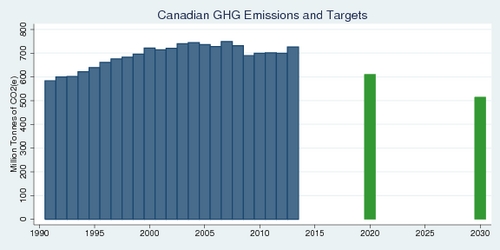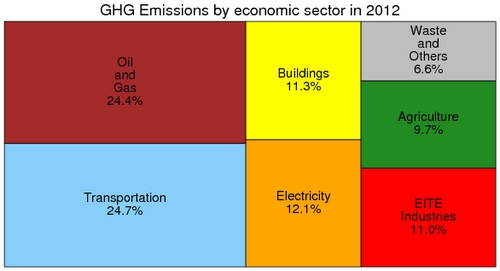In mid-May the federal government of Canada announced that it will commit the country to reducing greenhouse gas emissions by 30% below 2005 levels by 2030—or more precisely a 221 Megatonnes (Mt) reduction from 736 to 515 MT/year. Environment minister Aglukkaq declared this target as "fair and ambitious". Is this goal realistic? And is it ambitious compared to other leading world economies? Jeffrey Simpson called it An unambitious emissions target we won't even hit. Previously, the government had announced a 17% reduction over its 2005 levels by 2020: the "Copenhagen target". The chart below shows GHG emissions as reported by the GHG inventory, and the targets for 2020 and 2030 (green bars).

click on image for high-resolution PDF version
In 2012, one quarter each of Canada's emissions came from oil and gas production and transportation. Agriculture, buildings, electricity generation, and energy-intensive trade-oriented (EITE) industries accounted for about 10-12% each. The remainder originates from waste and other sources. Emissions from transportation and buildings are relatively inelastic to price signals, and this leaves the potential for major reductions to two sectors: oil and gas production, and electricity generation.
It is useful to disaggregate the 173 Mt of emissions from oil and gas sector further: conventional oil production (17%); oil sands (35%); natural gas production and processing (28%); oil and gas transmission (6%); downstream oil refining and gas distribution (13%). In other words, the "upstream" activities account for 87% of emissions. A rough-and-ready benchmark figure is that producing oil sands is associated with 32 tonnes of CO2 for every million barrels per day (MBD); or equivalently 87 kg of CO2 per barrel.

click on image for high-resolution PDF version
Will Canada be able to deliver on the promised reductions? In environmental eeconomics, changes in total emissions can be decomposed into three contributing sources: a scale effect from overall economic growth, a composition effect from sectoral changes in the economy (e.g., from pollution-intensive to pollution-free activities), and a technique effect from improvements in efficiency and reductions of pollution intensity through innovation and regulation. The technique effect is often decomposed further when it comes to greenhouse gas emissions. One way to reduce emission intensity is through switching from carbon-intensive fuels to less carbon-intensive or carbon-free fuels, for example switching from coal to natural gas, or from natural gas to solar power. A second source for reducing emission intensity is through the improvement of energy efficiency, for example in response to higher energy prices.
Expansion of oil and gas production throughout the country are expected to add over 100 Mt of emissions per year; that is the scale effect. Overall, the composition of Canada's economy will change little, and will contribute only little to emissions growth. Major reductions in emissions can only come from fuel switching and improvements in energy efficieny. The "low-hanging fruit" are in the electricity sector. The major challenge will be dealing with proposed expansions of oil and gas production.
Electricity Generation
Four-fifth of electricity generation in Canada is from carbon-free sources that include hydro, nuclear, and renewable sources. The remaining one-fifth includes coal and natural-gas plants. Regulations introduced in 2012 (SOR/2012-167) mandate a performance standard of 420 tonnes of CO2 per Gigawatthour for new coal-fired power plants, which will induce a shift towards carbon capture and storage (CSS) or a shift towards cleaner natural gas plants. However, this new regulation does not touch existing power plants—they remain "grandfathered" until 2030. Meaningful reductions in GHG emissions in the electricity sector can only be achieved by the replacement of existing coal plants with low-carbon or carbon-free energy sources.
In 2012, coal-fired power plants accounted for 63 Mt of emissions (compard to 19 from natural gas). Eliminating these 63 Mt is an entirely realistic and achievable goal for 2030. However, it will take more effort than the toothless SOR/2012-167 regulation.
Oil and Gas Production
Between 1990 and 2005, emissions from the oil and gas sector increased by 58 Mt, and by another 14 Mt between 2005 and 2012. This is largely due to increased production. After the collapse of the oil price in late 2014, the key question is whether the projected expansion of oil sands production will materialize. Doubts about these projections are justified. Significant expansion of oil production in Canada would offset any GHG reductions made elsewhere in the economy. But even assuming that oil sands production remains flat, and optimistically allowing for significant technological progress in bitumen processing and CCS could only reduce emission from the oil and gas sector by about 50 Mt.
Carbon Credits?
If reductions of carbon emissions in Canada are insufficient, will Canada buy carbon credits in foreign carbon markets to balance the "carbon books" and achieve the reduction target nominally? Under the 2007 Kyoto protocol, Canada can participate in the UNFCCC's Clean Development Mechanism (CDM) through which a country can invest in emission reduction projects in developing counties and receive certified emission reduction units (CERs) in return. Using CERs raises questions about their cost as well as the rigorousness of verification. In particular, CERs must meet the additionality criterion: carbon offsets must be emission reductions taht would not have occurred without the offset project. Often, additionality is difficult to demonstrate. The experience with CERs in the European Union Emissions Trading System (EU-ETS) has not been positive. An oversupply has reduced the price to a level where it is difficult to believe that emission reductions paid for through these credits are real. Oversupply of CERs may also contribute to the low carbon price in the EU-ETS. In 2014, carbon permits in the EU wher trading for €5/tonne and have since recovered to about €7.5/tonne in May 2015.
If Canada had to purchase 100 MT of CERs at, say, $10/tonne, it would cost the country one billion dollars. While this may well be a way to boost aid to poor countries, it may be difficult to find broad political support for this measure in the presence of more urgent domestic needs.
The bottom line
The federal government has announced a GHG target for 2030 that is wildly optimistic. Even allowing for no expansion of oil sands production, phasing out of coal plants, and significant progress with carbon capture and storage, achieving a reduction of even 100 Mt by 2030 is optimistic. Achieving a reduction of over 200 Mt would require policies that the current federal government is unwilling to contemplate—aggressive carbon pricing. With climate change, it's all to easy for the federal government to pass the buck to its distant successors. Who knows who will be in power in 2030? Politicians who make the decisions today will be enjoying their retirements in 2030. Perhaps leadership on climate change has to come from other quarters in our society.
‘Climate change disproportionately affects the poor.’
It is indeed encouraging to see that the world's religious leaders are taking a growing interest in climate change. In his June 2015 encyclical letter Laudatio Si' (on care for our common home), Pope Francis has called for action on climate change and criticized political myopia. He also drew the connection to poverty, noting that the brunt of the burden of climate change would be carried by the poor of this world. He says that "Many of the poor live in areas particularly affected by phenomena related to warming, and their means of subsistence are largely dependent on natural reserves and ecosystemic services such as agriculture, fishing and forestry." It is an important reminder that adaptation to climate change is affordable to rich nations, but not the poor. Thus rich countries, and that includes Canada, have a moral duty to tackle climate change. For Pope Francis, climate change has become a matter of social justice: across nations and communities, and across generations. Will politicians listen?
References:
- Jeffrey Simpson: An unambitious emissions target we won't even hit, The Globe and Mail, May 19, 2015.
- Canada's Greenhouse Gas Inventory with online data search by facility.
- OECD Environmental Outlook to 2050, Climate Change Chapter, November 2011.
- Environment Canada: Canada's Emissions Trends, October 2013
- Environment Canada: Canada's Emissions Trends, 2014
- James Kanter: E.U. Faces Oversupply of Carbon Credits, The New York Times, October 27, 2009
- Stanley Reed and Mark Scott: In Europe, Paid Permits for Pollution Are Fizzling and The Falling Price of Carbon Credits, The New York Times, April 21, 2013
- Elizabeth Renzetti: With climate encyclical, the Pope has knocked one out of St. Peter's, The Globe and Mail, June 19, 2015.
![[Sauder School of Business]](logo-ubc-sauder-2016.png)
![[The University of British Columbia]](logo-ubc-2016.png)